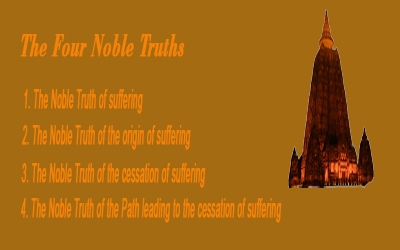“Setting in Motion the Wheel of the Dhamma”
“Dhammacakka” is frequently rendered “the wheel of truth”, “the wheel of Righteousness”, etc. According to commentators “Dhamma” here means wisdom or knowledge, and “Cakka” means establishment.
According to the Mahāvagga belong to the Vinaya Piṭaka, the Buddha preaches the Dhammacakka which is His first semon to five monks (Pañcavaggiya) at Isipatana, on the full moon day of Asāḷah.
In this discourse the Buddha preaches the Four Noble Truths, the Noble Eightfold Path as call the Middle Path (Majjiāpatipadā). He opens the discourse by advising the monks to avoid the two extremes of sensual indulgence and self-mortification with stating as follows:
“These two extremes, Bhikkhus, should not followed by one who has gone out from home to homeless life. What are these two extremes?
1. The giving up to the pleasure of sense (Kāmasukhanlikānuyoga) which is base, vulgar, worldly, ignoble and profitless.
2. The giving up to self-mortification (Attakilamathānuyoga) which is painful, ignoble and profitless.
By avoiding up these two extremes, Bhikkhu, the Tathāgata has gained the knowledge of the middle path (Majjhimāpatipada) which leads to insight, knowledge, which leads to peace (Vupasamāya), higher wisdom (Abhiññāya), Enlightenment (Samboddhāya), and Nibbāna.
And what, Bhikkhu, is that Middle Path which id found out by the Tathāgata which leads to insight, to knowledge, which leads to peace, higher wisdom, Enlightenment, and Nibbāna? It is the Noble Eightfold Path, namely –
– Right View (Sammā Diṭṭhi)
– Right Intention (Sammā Saṅkappa)
– Right Speech (Sammā Vācā)
– Right Action (Sammā Kammanta)
– Right Livelihood (Sammā Ājiva)
– Right Effort (Sammā Vāyāma)
– Right Mindfulness (Sammā Sati)
_ Right Concentration (Sammā Samādhi)
Each factor of the Noble Eightfold Path helps one another in order to lead to the cessation of the suffering. It should be understood some of its brief meaning, as follows:
- Right View is the understand of things as they are, and it is ultimately reduced to the Four Noble Truths.
- Right Intention means renunciation negative thoughts, such as attachment, anger, and cruelty, and replacing them with wholesome thoughts, such as tolerance, compassion, and love.
- Right Speech means the from false speech, slandering, harsh words, and frivolous talk.
- Right Action aims at the refraining from killing, stealing and sexual misconduct.
- Right Livelihood means that one should abstain from making wrong living that brings harm to others, but should live by a profession which is honorable, blameless.
- Right Effort is the energetic will to prevent evil from arising, to get rid of such demeritorious things that have already arisen, to cause to arise wholesome state of mind not yet arisen, and to develop the perfect of wholesome.
- Right Mindfulness means that one dwells in contemplation of four objects, viz body, feeling, thought and mind objects.
- Right Concentration means that one is detached from sensual objects, from unwholesome things. Strictly speaking, it is the state of mind remaining into the four stages of Jhāna.
And the Buddha gave the Four Noble Truths (Cattāri – Ariyasaccāni), namely –
- The Noble Truths of suffering (Dukkha – Ariyasaccā): The first of Noble Truths is suffering of birth, decay, disease, death, association with undesired thing, separation from the loved thing, not to obtain what we desire. In short, these five aggregates which are the objects of grasping are suffering.
- The Noble Truths of the origin of suffering (Dukkha – Samudaya – Ariyasaccā): It is the craving for sensual pleasure (Kāma taṇhā), the craving for continued existence (Bhava taṇhā), and the craving for non-existence (Vibhava taṇhā).
- The Noble Truths of the cessation of suffering (Dukkha – Nirodha Ariyasaccā): it is the remainderless fading away and cessation of that same craving, the giving up and relinquishing of it, freedom from it, nonreliance on it.
- The Noble Truths of the Path leading to the cessation of suffering (Dukkha – Nirodha Gāminī – Patipadā – Ariyasaccā): It is the Noble Eightfold Path, viz. Right View, Right Intention, Right Speech, Right Action, Right Livelihood, Right Effort, Right Mindfulness, Right Concentration.
The Blessed One teached further that:
– The sufering should be fully understood (Priññeyya)
– The origin of suffering should be eradicated (Pahātabbā)
– The cessation of suffering should be realized (Sacchikātabbā)
– The path leading the cessation of suffering or Magga should be cultivated (Bhāvetabbā)
After having finished the sermon, out of five ascetics, Kondañña was the first to Enlighten the Dhamma. Thereupon, the Buddha uttered this solemn saying “Kondañña indeed has understood, Kondañña indeed das understood”. Thus the Venerable Kondañnna won his name of Aññāta Kondañña, the one who has understood.
The Dhammacakkappavattana Sutta is very important to understand the basic teachings of Buddhism. It can be said that the whole teaching of the Buddha is contained in the Four Noble Truths. These are the truths that lead to insight, to true knowledge, to peace, to Enlightenment and to Nirvana.
Compiled by Phap Luu Home


